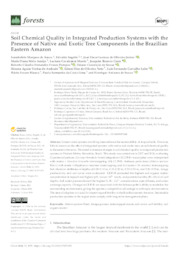Soil chemical quality in integrated production systems with the presence of native and exotic tree components in the Brazilian Eastern Amazon.
Soil chemical quality in integrated production systems with the presence of native and exotic tree components in the Brazilian Eastern Amazon.
Author(s): SOUZA, I. M. de; SAGRILO, E.; OLIVEIRA JUNIOR, J. O. L. de; ARAÚJO, M. D. M.; MUNIZ, L. C.; COSTA, J. B.; POMPEU, R. C. F. F.; SOUSA, D. C. de; ANDRADE, H. A. F. de; OLIVEIRA NETO, E. D. de; LEITE, L. F. C.; BLANCO, F. F.; LIMA, P. S. da C.; SOUZA, H. A. de
Summary: Conservation systems involving trees enhance the sustainability of tropical soils. However, little is known on the effect of integrated systems with native and exotic trees on soil chemical quality in the eastern Amazon.
Publication year: 2024
Types of publication: Journal article
Unit: Embrapa Mid-North
Observation
Some of Embrapa's publications are published as ePub files. To read them, use or download one of the following free software options to your computer or mobile device. Android: Google Play Books; IOS: iBooks; Windows and Linux: Calibre.
Access other publications
Access the Agricultural Research Database (BDPA) to consult Embrapa's full library collection and records.
Visit Embrapa Bookstore to purchase books and other publications sold by Embrapa.

